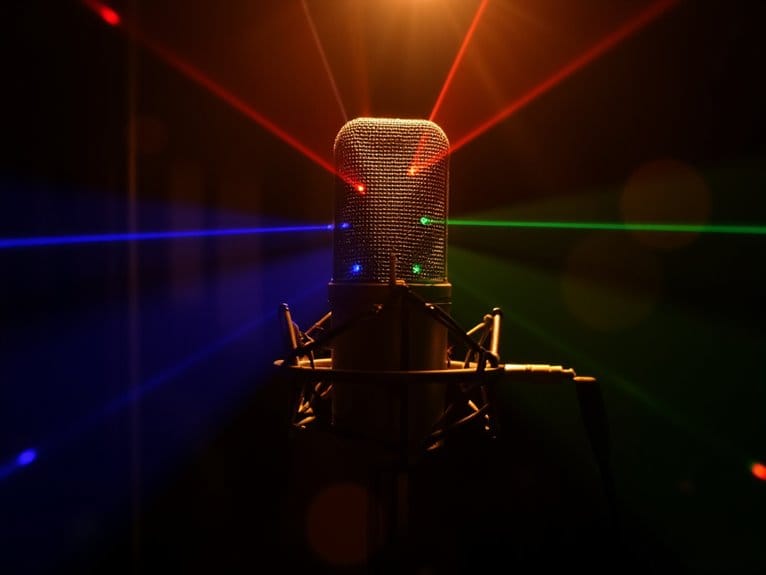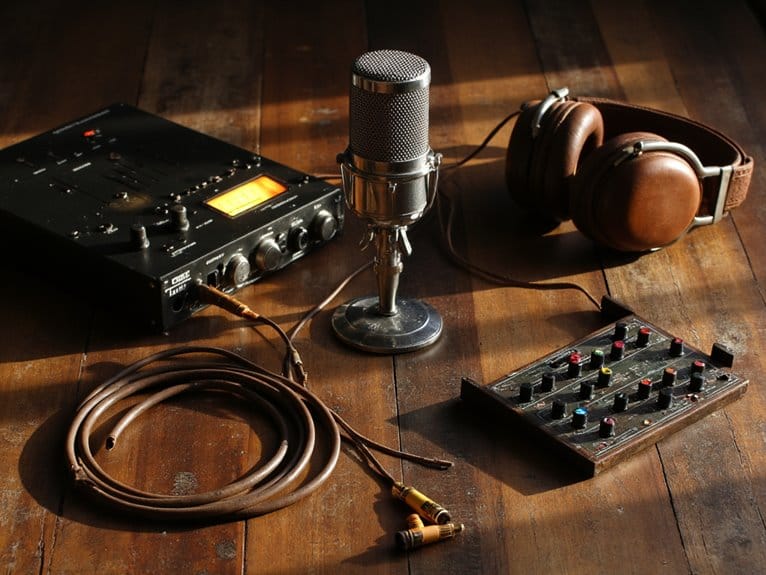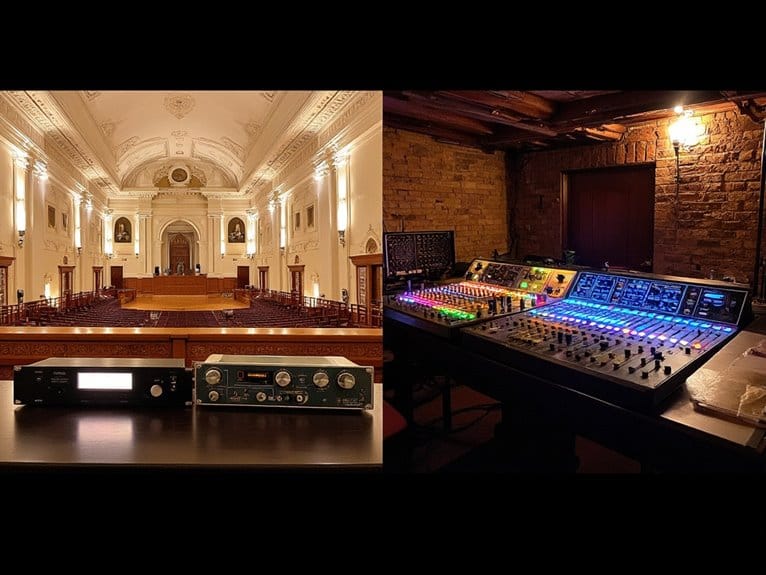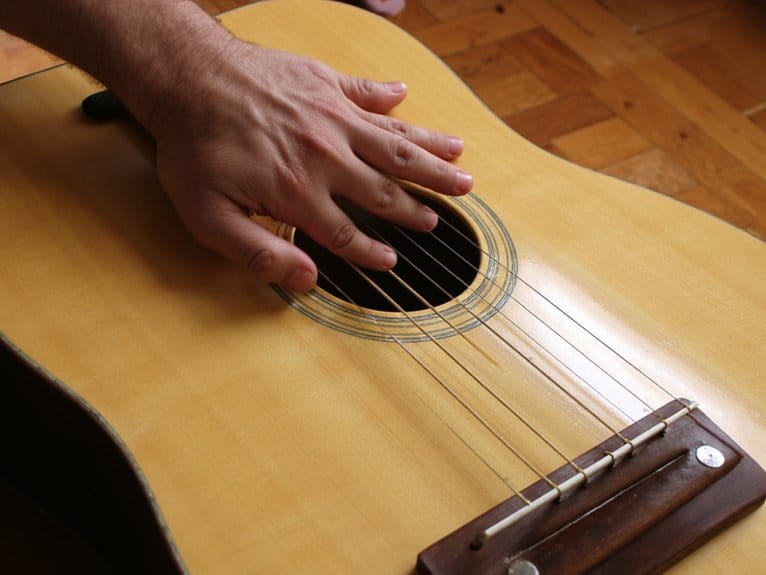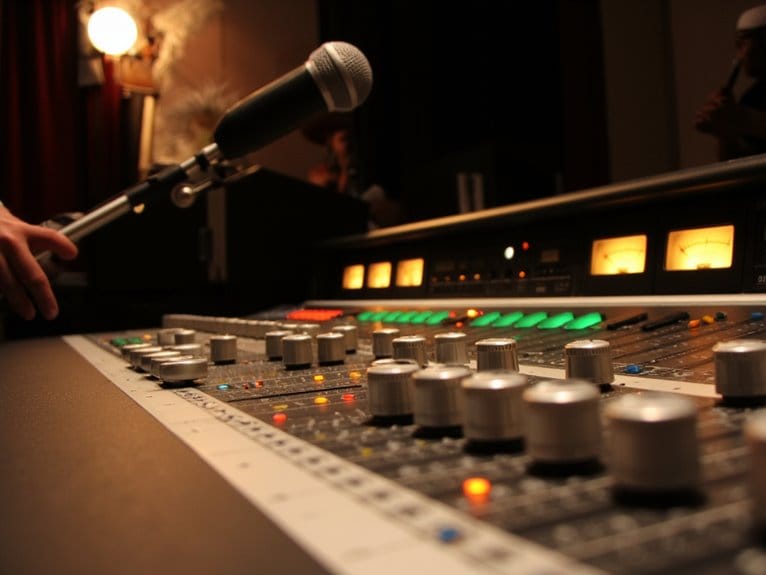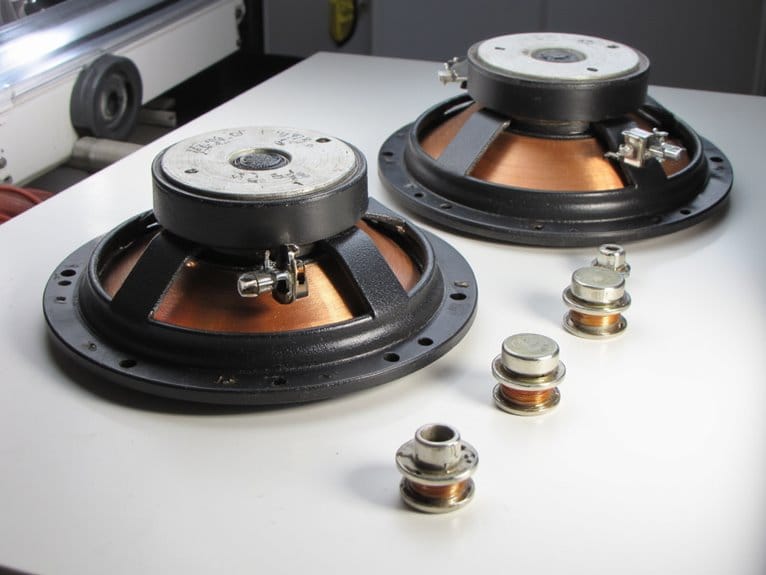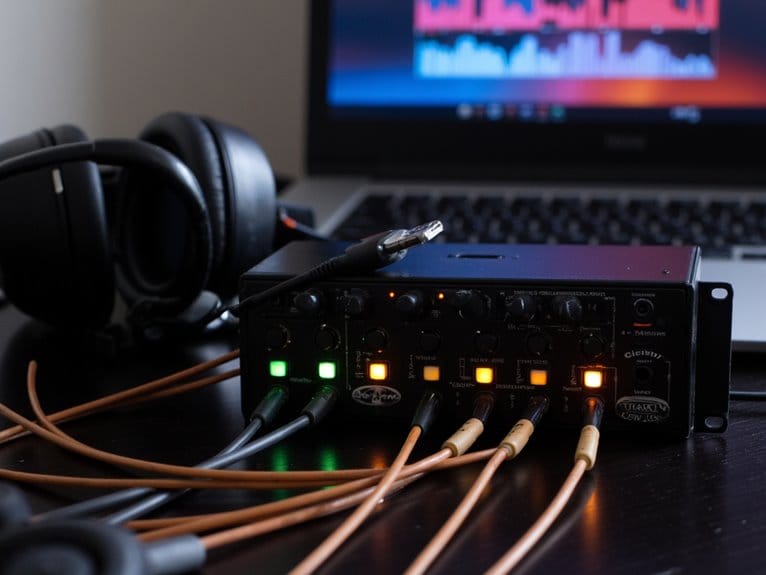Understanding Microphone Polar Patterns Explained
Microphone polar patterns define how your mic captures sound from different directions, fundamentally creating a three-dimensional sensitivity map around the capsule. Cardioid patterns excel at front-facing pickup while rejecting rear noise by 75%, making them perfect for vocals and live performances. Omnidirectional mics capture sound equally from all directions, ideal for group recordings and natural ambient capture. Supercardioid and hypercardioid patterns offer tighter directional control with enhanced feedback rejection. Understanding these patterns helps you choose the right microphone for your specific recording environment, and there’s considerably more to explore about optimizing your audio setup.
We are supported by our audience. When you purchase through links on our site, we may earn an affiliate commission, at no extra cost for you. Learn more.
Notable Insights
- Polar patterns define how microphones respond to sound from different directions, creating a directional hearing map for audio capture.
- Cardioid patterns capture sound from the front while rejecting rear noise, making them ideal for live performances and vocal recording.
- Omnidirectional microphones pick up sound equally from all directions, perfect for group recordings and capturing natural ambient environments.
- Supercardioid and hypercardioid patterns offer tighter directional control than cardioid, providing superior sound isolation and feedback rejection.
- Pattern selection impacts audio quality by controlling ambient noise, room acoustics, and frequency response characteristics in recordings.
What Are Microphone Polar Patterns
When I first started working with microphones, I’ll admit I was completely baffled by those strange spider-web diagrams that seemed to accompany every mic specification sheet.
Those mysterious charts, called polar patterns or pickup patterns, actually define how your microphone responds to sound waves arriving from different directions around its central axis. Think of them as your mic’s directional hearing map, showing exactly where it’s most sensitive to incoming audio.
Different microphone types utilize specific polar patterns to achieve ideal sound isolation and capture quality.
These patterns help you isolate your desired sound source while minimizing unwanted ambient noise, room reflections, and background interference that can muddy your recordings and compromise the clarity you’re working so hard to achieve. The polar pattern characteristics exist in a three-dimensional space originating from the microphone capsule, creating distinct shapes that determine how your microphone will perform in various recording environments. The cardioid polar pattern is particularly effective at minimizing background noise while focusing on the primary sound source directly in front of the microphone. Understanding polar patterns allows you to craft the perfect balance between direct sound and natural room acoustics in your recordings.
Cardioid Polar Pattern Characteristics and Uses
When you’re working with a cardioid microphone, you’ll notice it captures sound most effectively from directly in front while dramatically reducing what comes from behind, creating that characteristic heart-shaped pickup pattern that makes it incredibly useful for isolating your intended sound source.
This front-facing sensitivity becomes particularly valuable during live performances, where you need clear vocal pickup without the stage monitors, drums, or crowd noise bleeding into your signal and creating that dreaded feedback squeal we’ve all experienced. The cardioid pattern helps minimize feedback by rejecting sound from monitors positioned behind the microphone. Professional dynamic microphones like the Shure SM58 utilize cardioid polar patterns specifically for this background noise rejection capability.
I’ve found that understanding this directional behavior helps you position yourself correctly, typically staying within that sweet spot directly in front of the mic where your voice sounds full and present. The X/Y stereo technique uses paired cardioid microphones positioned at 90 degrees to capture a natural stereo image with excellent phase coherence.
Front-Facing Sound Sensitivity
Anyone who’s spent time around microphones has likely encountered the cardioid pattern, which remains the most popular and versatile polar pattern in audio recording due to its distinctive heart-shaped sensitivity design that captures sound primarily from the front while rejecting noise from behind.
The front sensitivity of cardioid microphones creates exceptional sound isolation through several key characteristics:
- Peak sensitivity at 0° – Maximum pickup directly in front of the microphone capsule.
- Gradual side attenuation – Sensitivity decreases smoothly toward the microphone’s sides.
- 20 dB rear rejection – Sound from behind is reduced by approximately 75%.
- Proximity effect enhancement – Increased bass response when sources move closer.
This directional design makes cardioid mics perfect for vocals, instruments, and podcasting where you need focused capture while minimizing ambient noise and feedback. The cardioid pattern’s frequency-dependent directionality means that lower frequencies exhibit stronger directional characteristics than higher frequencies, which affects the microphone’s overall pickup behavior across the audio spectrum. This characteristic is crucial for applications like live sound reinforcement and studio recording, where clarity and presence are paramount. When considering mic options, understanding the microphone frequency response explained can help users choose a model that complements their sound sources. Additionally, factors such as proximity effect and off-axis response should be taken into account for optimal performance in various settings.
Cardioid microphones are the simplest polar pattern to manufacture, which explains their widespread adoption across both professional and consumer audio equipment.
Live Performance Applications
Once you step onto a live stage, cardioid microphones become your primary defense against the chaotic sonic environment that surrounds every performance, offering unmatched directional control that separates your voice or instrument from the competing sounds of monitors, amplifiers, and ambient crowd noise.
| Application | Benefit | Technical Advantage |
|---|---|---|
| Lead Vocals | Enhanced vocal clarity | Front sensitivity with rear rejection |
| Live Mixing | Reduced feedback | Minimizes monitor bleed |
| Multi-Mic Setup | Clean separation | Predictable directional response |
You’ll find that cardioid mics excel in live mixing scenarios because their heart-shaped pickup pattern naturally isolates your sound source while rejecting unwanted stage noise, enabling sound engineers to maintain vocal clarity even in crowded frequency environments where multiple instruments compete for sonic space. This heart-shaped pattern makes cardioid microphones particularly suitable for close miking applications where precise directional control prevents interference from nearby sound sources.
Omnidirectional Pattern for All-Around Sound Capture
When you’re looking to capture sound from every direction with uniform sensitivity, omnidirectional microphones become your go-to choice, offering that distinctive circular pickup pattern that treats all angles equally around the capsule.
I’ve found these mics particularly valuable for group recording scenarios like round-table discussions or ensemble vocals, where you need to capture multiple sound sources positioned around the microphone without favoring any particular direction.
However, you’ll want to carefully consider your ambient environment since omnidirectional mics capture everything indiscriminately, including room acoustics, background noise, and reflections that directional microphones would typically reject. The omnidirectional pattern makes them especially suitable for film and video productions where natural ambient sound enhances the overall audio experience.
Unlike their directional counterparts, omnidirectional microphones maintain natural sound quality that’s less affected by off-axis coloration, making them ideal for capturing authentic acoustic environments.
Equal Directional Sound Pickup
Unlike the focused pickup patterns I’ve discussed previously, omnidirectional microphones capture sound equally from all directions around their capsule, creating what’s fundamentally a 360-degree listening experience that mirrors how we naturally hear our surroundings.
The omnidirectional microphone advantages become clear when you’re recording in natural acoustic environments, where uniform sensitivity guarantees consistent audio quality regardless of positioning.
Here’s what makes this pattern unique:
- No directional bias – sounds receive equal treatment from every angle
- Eliminates proximity effect – bass frequencies stay natural at any distance
- Captures authentic ambient sound effects – room tone and environmental audio blend seamlessly
- Simplifies placement – orientation doesn’t affect pickup quality
You’ll find these mics excel in orchestra recordings and field work, though they’ll also pick up unwanted background noise in uncontrolled environments. The electromagnetic induction principle that drives these microphones ensures reliable conversion of sound waves into electrical signals through diaphragm movement within magnetic fields.
Group Recording Applications
While single-speaker recordings benefit from focused pickup patterns, group recording scenarios demand a fundamentally different approach that leverages omnidirectional microphones‘ unique ability to capture voices equally from every direction around the capsule.
You’ll find that strategic microphone placement, typically overhead or centrally positioned among participants, eliminates the need for multiple units while ensuring consistent audio clarity across all speakers.
This approach works exceptionally well for conference calls, panel discussions, and focus groups where participants naturally shift positions during conversations.
I’ve observed that omnidirectional mics capture the natural acoustic blend of voices and room characteristics, creating more realistic recordings than directional alternatives that often miss off-axis speakers or require constant repositioning throughout sessions.
Ambient Environment Considerations
Beyond the controlled dynamics of group recordings, omnidirectional microphones truly excel when you’re capturing the complete sonic environment, where every sound contributes to the authentic atmosphere of your recording space.
These versatile tools don’t require precise placement, making them particularly valuable for outdoor soundscapes where sounds emerge from unpredictable directions.
When you’re working with ambient environment considerations, omnidirectional mics offer distinct advantages:
- Natural soundscape capture – They record authentic environmental audio without directional bias
- Reduced positioning complexity – You won’t spend time fine-tuning placement angles
- Multi-source recording capability – Simultaneous capture of various sound sources becomes effortless
- Enhanced ambient noise capture – Every environmental detail contributes to immersive recordings
This all-encompassing approach guarantees you’ll achieve balanced, natural-sounding recordings that truly represent your acoustic environment.
Figure-8 Bidirectional Pattern Applications
I’ve spent countless hours experimenting with figure-8 microphones in various recording scenarios, and I can tell you that their unique bidirectional pickup pattern opens up creative possibilities that other microphone types simply can’t match.
The figure 8 advantages become immediately apparent when you’re recording two vocalists facing each other, capturing both performances while completely rejecting unwanted side noise from monitors or instruments. I’ve found them invaluable for stereo recording techniques like Mid/Side configurations, where the spatial imaging precision is remarkable.
However, the figure 8 limitations include sensitivity to placement and handling noise, plus they’re not ideal when you need side sound pickup, making careful positioning absolutely critical for best outcomes.
Supercardioid and Hypercardioid Patterns Explained
Moving beyond the unique challenges of figure-8 patterns, I’ve discovered that supercardioid and hypercardioid microphones offer a compelling middle ground between the broad pickup of standard cardioids and the extreme directionality of shotgun mics, though their subtle differences can make or break your recording depending on the application.
Here’s what sets these patterns apart:
- Pickup Angles: Supercardioid mics capture approximately 115° front pickup, while hypercardioid patterns narrow to 105°.
- Rear Sensitivity: Hypercardioid patterns feature more prominent rear lobes than supercardioid designs.
- Feedback Control: Supercardioid advantages include better feedback rejection for live performances.
- Isolation: Hypercardioid applications excel in precise source isolation and ambient noise rejection.
Understanding these nuances helps you choose the right directional tool for your specific recording environment.
Shotgun Microphones for Directional Recording
When you need to capture audio from a distance while cutting through environmental chaos, shotgun microphones represent the pinnacle of directional recording technology, achieving their remarkable focus through a sophisticated interference tube that creates destructive wave patterns to cancel off-axis sound.
This shotgun microphone design utilizes tube length to determine frequency-dependent directionality, with longer tubes providing superior low-frequency rejection.
You’ll notice their lobar polar pattern creates incredibly tight pickup angles, narrowing from 105° at low frequencies to just 25° at 16 kHz.
The off-axis rejection becomes more pronounced as frequency increases, with Directivity Index values climbing from 6 dB at 1 kHz to over 13 dB at 16 kHz, making them indispensable for film production, wildlife recording, and any scenario requiring precise sound isolation. Modern shotgun microphones achieve their exceptional performance through high signal-to-noise ratios of up to 74 dB, ensuring crystal clear audio capture even in challenging recording environments. These characteristics not only elevate the recording quality for professional use but also make it crucial for content creators seeking the best USB microphone for vocals. With the ability to focus on the desired sound source while minimizing background noise, these microphones are incredibly versatile. As a result, they are favored not only in film and wildlife settings but also for podcasters and musicians aiming for studio-quality results. In addition, many modern shotgun microphones come equipped with features like low-cut filters and adjustable sensitivity, further enhancing their adaptability across various recording situations. This versatility makes them an excellent choice for those seeking the best USB microphone for recording music, as they can capture the nuances of vocal performances and instrumental details with remarkable clarity. Ultimately, their advanced technology not only meets the demands of professionals but also empowers amateur creators to achieve studio-quality recordings in any environment.
For optimal performance in outdoor environments, pairing shotgun microphones with windscreens becomes essential to mitigate wind interference that can compromise their directional advantages. Different microphone windscreen types explained can help users choose the right option based on their specific recording environment. For instance, foam windscreens are excellent for light wind and indoor settings, while furry windscreens, or dead cats, provide superior protection against strong winds outdoors. Selecting the appropriate windscreen not only enhances audio quality but also ensures that the nuanced sounds are captured without distortion.
Wide Cardioid Pattern Benefits
The sweet spot between focused directionality and natural ambient capture, wide cardioid patterns offer a compelling compromise that I’ve found particularly valuable when standard cardioid feels too restrictive and omnidirectional picks up excessive room noise.
These wide cardioid advantages become apparent when you’re recording groups or working in acoustically challenging environments where you need controlled sound capture without harsh rejection zones.
Here’s what makes wide cardioid patterns exceptionally useful:
- Natural sound quality with smoother sensitivity shifts around the microphone
- Reduced proximity effect compared to standard cardioid patterns, preserving tonal balance
- Forgiving placement requirements that accommodate less precise microphone positioning
- Balanced ambient inclusion that captures room character without overwhelming the primary source
You’ll appreciate how this pattern eliminates the tunnel-like effect of tighter directional microphones while maintaining better isolation than omnidirectional options.
Choosing Patterns for Live Performance Settings
Unlike studio environments where you can control acoustics and monitor placement with precision, live performance settings demand microphone polar patterns that can handle unpredictable variables like crowd noise, stage volume, and feedback loops while still delivering clear, isolated sound.
I’ve found that cardioid patterns dominate live sound reinforcement because they reject monitor signals positioned behind performers, dramatically reducing feedback while maintaining excellent vocal clarity.
When stages get particularly loud, supercardioid patterns offer even tighter directional control, though you’ll need to watch their rear pickup lobes carefully.
For feedback management, directional patterns consistently outperform omnidirectional mics, which pick up everything—including that drummer who never learned volume control.
Your pattern choice directly impacts how much stage bleed contaminates your mix.
Dynamic microphones with cardioid patterns typically deliver gain before feedback ratings that are 15-20 dB higher than condenser microphones, making them significantly more suitable for high-volume live environments. This characteristic allows dynamic microphones to maintain clarity and reduce unwanted noise, which is crucial when performing in front of large audiences. Additionally, their durability makes them an appealing choice for musicians on the go. For those looking to enhance their streaming quality, dynamic microphones are often considered among the best microphones for streaming audio due to their robustness and ability to capture sound accurately in less-than-ideal environments.
Industry-standard microphones like the Shure SM58 demonstrate how cardioid patterns excel in live settings, with their tailored frequency response enhancing vocal performance while minimizing unwanted ambient pickup.
Studio Recording Pattern Selection
While live performance demands patterns that fight feedback and stage bleed, studio recording opens up a world of creative possibilities where you can choose patterns based purely on sonic goals rather than survival instincts.
Studio pattern selection becomes an art form where each polar pattern serves specific recording technique comparison purposes:
In the studio, microphone polar patterns transform from survival tools into precision instruments for sculpting your sonic vision.
- Cardioid patterns deliver natural vocal warmth through proximity effect while rejecting room noise, making them your go-to choice for close-miking vocals and instruments.
- Supercardioid and hypercardioid patterns provide tighter isolation for louder sources, though they require more precise placement to avoid rear pickup issues.
- Figure-8 patterns excel at capturing duets or stereo techniques like Mid-Side recording, picking up front and rear while rejecting sides.
- Omnidirectional patterns capture natural room ambience without proximity effect, perfect for acoustic instruments in well-treated spaces. The wide frequency response of condenser microphones makes them particularly effective with omnidirectional patterns for capturing the full range of acoustic instruments.
For classical guitar recording, cardioid and supercardioid patterns effectively capture the instrument’s nuanced tones while rejecting background noise, with supercardioid patterns providing narrower pickup angles that require more precise positioning near the sound hole.
Cardioid and supercardioid patterns offer superior sound isolation by rejecting background noise from behind and the sides, making them invaluable in crowded environments.
Understanding microphone sensitivities helps you navigate challenging acoustics—shotgun mics excel in noisy outdoor venues, while bidirectional patterns can introduce unwanted reflections in reverberant spaces.
Wind, humidity, and reflective surfaces all conspire against poor pattern choices, forcing you to prioritize practical performance over creative ideals.
Supercardioid patterns provide tighter pickup and enhanced gain before feedback compared to standard cardioid designs, making them particularly effective for high-volume live performance scenarios.
Dynamic cardioid microphones excel in live performance environments by focusing on front-facing sound sources while effectively rejecting unwanted ambient sound that could compromise your recording quality.
Frequently Asked Questions
Can You Change a Microphone’s Polar Pattern After Purchase?
You can change a microphone’s polar pattern after purchase only if you’ve bought a switchable-pattern model, which offers polar pattern versatility through internal dual elements and switching mechanisms.
However, most consumer microphones face significant microphone design limitations since they’re fixed-pattern types.
I’ve found that while high-end condensers like the Josephson C700 series provide this flexibility, standard mics can’t be practically modified without compromising their acoustic integrity.
Do Polar Patterns Affect Microphone Price and Quality Ratings?
Your microphone’s polar pattern doesn’t directly dictate microphone pricing or quality standards, though I’ve noticed it influences both indirectly.
You’ll find cardioid and omnidirectional patterns across budget to premium tiers, while specialized patterns like shotgun designs might cost more due to engineering complexity, not the pattern itself.
Quality ratings depend more on build materials, capsule technology, and how well the pattern suits your specific recording environment and application needs.
Which Polar Pattern Works Best for Recording Musical Instruments?
I’ve found that cardioid patterns work best for most musical recording since they capture excellent dynamic range while rejecting background noise, though your choice depends on specific instrument types.
For solo guitars or drums, you’ll want cardioid’s focused pickup, while bidirectional patterns excel when recording two instruments simultaneously.
Supercardioid offers tighter isolation for noisy environments, but omnidirectional captures ensemble performances beautifully.
How Do Weather Conditions Impact Microphone Polar Pattern Performance?
Weather effects dramatically alter microphone sensitivity across all polar patterns, with extreme temperatures causing diaphragm stiffening and capacitance changes that shift directional accuracy.
I’ve found humidity particularly problematic for condensers, degrading their polar pattern precision, while dynamic mics maintain better stability.
Wind noise overwhelms pattern focus, requiring proper windscreens to preserve directionality.
You’ll need specialized field microphones for consistent performance in harsh conditions.
What Polar Pattern Should Beginners Start With for Home Recording?
You should start with cardioid patterns for home recording because they capture sound primarily from the front while rejecting unwanted room noise from sides and back.
I’ve found cardioid benefits include reduced feedback and enhanced versatility across vocals and instruments.
While omnidirectional uses include natural ambience capture, they pick up too much background noise in untreated rooms, making cardioid your best beginner choice.
On a final note
You’ll find that choosing the right polar pattern isn’t rocket science, though I’ve certainly made my share of mistakes over the years. Whether you’re recording vocals with a cardioid, capturing room ambience with an omnidirectional, or isolating instruments with a figure-8, understanding these patterns will dramatically improve your audio quality. Match your microphone’s pickup pattern to your specific recording environment and source material for ideal results.

